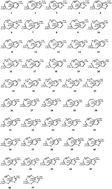A study of the aromaticity and ring currents of azulene and azaazulenes
Abstract
The global aromaticity of azaazulenes has been investigated using topological resonance energy (TRE), percentage topological resonance energy (% TRE), and magnetic resonance energy (MRE) methods. The impact of nitrogen atoms on the aromaticity of azazulenes is discussed. The aromaticity results obtained by the TRE and % TRE methods were compared with the nucleus independent chemical shift (NICS(0)) values at the cage center. We found discrepancies between the NICS(0) predictions and our results. We have found that the aromaticity of the azaazulenes depends strongly on the substituted position of the nitrogen atoms on the ring. The local aromaticity was studied using bond resonance energy (BRE) and circuit resonance energy (CRE) indices. The BRE and CRE results show that the 10π-electron peripheral rings play an important role in both the global and local aromaticity of these compounds. Ring current (RC) results show that all the azaazulenes sustain diamagnetic currents regardless of any predicted antiaromaticity.


 Please wait while we load your content...
Please wait while we load your content...